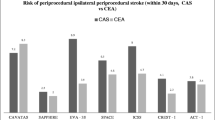Abstract
The treatment of carotid artery stenosis currently constitutes a major component of vascular surgical practice. Carotid angioplasty and stenting (CAS), however, is mainly performed by nonvascular surgeon interventionalists with cerebral protection devices available only through investigational protocols. This study reports the initial results of a CAS program initiated and performed by vascular surgeons using commercially available cerebral protection devices. Fifty-seven patients were enrolled in the study over a 14-month period. All patients were at high risk for conventional endarterectomy (7 resentosis, 4 irradiation, and 46 medically high-risk ASA III). Mean age was 75.7 years (range, 45-93 years). High-grade stenosis of the carotid artery was present in all cases (mean stenosis, 85%; range, 80-99%). Twenty-four percent of patients were symptomatic. Cerebral protection was performed with an occlusion balloon-wire in 32 cases and with a filter-wire device in 24; no cerebral protection was used in 1 patient with restenosis after endarterectomy. Initially in the study, atropine was administered selectively for the development of bradycardia. Currently atropine is administered routinely prior to the initial balloon angioplasty of the carotid bulb. Clopidogrel (75 mg/day) was administered for 5 days prior to CAS and for 30 days after CAS. All 57 patients underwent successful dilatation of their carotid stenoses without occlusion or dissection. Ten of 32 patients in whom balloon occlusion was used for cerebral protection exhibited transient evidence of cerebral ischemia during protection balloon occlusion. These symptoms resolved completely without permanent neurological deficit in all cases. Development of bradycardia with a heart rate <50 bpm was significantly reduced by routine administration of atropine prior to the initial dilatation within the carotid bulb (p = 0.01). Mean hospital length of stay was 1.33 days (range, 1-5 days). There were two periprocedure myocardial infarctions, two postprocedure transient ischemic attacks, and one reversible ischemic neurologic deficit. There was no 30-day mortality. There have been no instances of hemodynamically significant restenosis during a mean follow-up period of 5.4 months. From these results we have concluded that CAS can be performed effectively and safely using commercially available cerebral protection devices. A program initiated and performed exclusively by vascular surgeons is effective and should be the standard model used in the endovascular treatment of carotid artery stenosis.



Similar content being viewed by others
References
JS Yadav GS Roubin S Iyer J Vitek P King WD Jordan et al. (1997) ArticleTitleElective stenting of the extreacranial carotid arteries Circulation 95 376–381 Occurrence Handle1:STN:280:ByiC287hvFE%3D Occurrence Handle9008452
EB Deitrich M Ndiaye DB Reid (1996) ArticleTitleStenting in the carotid artery: initial experience in 110 patients J. Endovasc. Surg. 3 42–62
JG Theron GG Payelle O Couskun HF Huet L Guimaraens (1996) ArticleTitleCarotid artery stenosis: treatment with protedced balloon angioplasty and stent placement Radiology 201 627–636 Occurrence Handle1:STN:280:ByiD1MzmslU%3D Occurrence Handle8939208
(2001) “Endovascular versus surgical treatment in patients with carotid stenosis in the Carotid and Vertebral Artery Transluminal Angioplasty Study (CAVATAS): a randomised trial” Lancet 357: 1729–1737
GS Roubin G New SS Iyer JJ Vitek N Al-Mubarek MW Lin JS Yadav et al. (2001) ArticleTitleImmediate and late clinical outcomes of carotid artery stenting in patients with symptomatic and asymptomatic carotid artery stenosis: a 5-year prospective analysis Circulation 103 532–537 Occurrence Handle1:STN:280:DC%2BD3M3is1aqtw%3D%3D Occurrence Handle11157718
MH Wholey N Al-Mubarek MH Wholey (2003) ArticleTitleUpdated review of the global carotid artery stent registry Catheter Cardiovasc. Interv. 60 259–260
G Dangas JR Laird SuffixJr R Mehran et al. (2001) ArticleTitleCarotid artery stenting in patients with high-risk anatomy for carotid endarterectomy J. Endovasc. Ther. 8 39–43
M Henry I Henry C Klonaris et al. (2002) ArticleTitleBenefits of cerebral protection during carotid stenting with the PercuSurge GuardWire system: midterm results J. Endovasc. Ther. 9 1–13
JC Parodi R La Mura LM Ferreira et al. (2000) ArticleTitleInitial evaluation of carotid angioplasty and stenting with three different cerebral protection devices J. Vasc. Surg. 32 1127–1136
JS Yadav (2002) ArticleTitleStenting and angioplasty with protection in patients at high risk for endarterectomy: the SAPPHIRE study Circulation 106 2986–a
JL Mas G Chantellier B Beyssen InstitutionalAuthorNamefor EVA-3S Investigators (2004) ArticleTitleCarotid angioplasty and stenting with and without cerebral protection: clinical alert from the Endarterectomy Versus Angioplasty in Patients with Symptomatic Severe Carotid Stenosis (EVA-3S) trial Stroke 35 e18–20 Occurrence Handle14657456
T Ohki FJ Veith S Grenell et al. (2002) ArticleTitleInitial experience with cerebral protection devices to prevent embolization during carotid artery stenting J. Vasc. Surg. 36 1175–1185
S Macdonald GS Venables TJ Cleveland PA Gaines (2002) ArticleTitleProtected carotid stenting: safety and efficacy of the MedNova NeuroShield filter J. Vasc. Surg. 35 966–972
FJ Criado JM Lingelbach DF Ledesma PR Lucas (2002) ArticleTitleCarotid artery stenting in a vascular surgery practice J. Vasc. Surg. 35 430–434
MH Wholey MH Wholey WA Tan G Eles C Jarmolowski S Cho (2003) ArticleTitleA comparison of balloon-mounted and self-expanding stents in the carotid arteries: immediate and long-term results of more than 500 patients J. Endovasc. Ther. 10 171–181
RW Hobson Suffix2nd BK Lal E Chakhtoura et al. (2003) ArticleTitleCarotid artery stenting: analysis of data for 105 patients at high risk J. Vasc. Surg. 37 1234–1239
A Cremonesi R Manette F Setacci C Setacci F Castriota (2003) ArticleTitleProtected carotid stenting: clinical advantages and complications of embolic protection devices in 442 consecutive patients Stroke 34 1936–1941 Occurrence Handle10.1161/01.STR.0000081000.23561.61 Occurrence Handle12843347
Author information
Authors and Affiliations
Corresponding author
About this article
Cite this article
Faries, P.L., Dayal, R., Clair, D.G. et al. Continuity in the Treatment of Carotid Artery Disease: Results of a Carotid Stenting Program Initiated by Vascular Surgeons. Ann Vasc Surg 18, 669–676 (2004). https://doi.org/10.1007/s10016-004-0101-y
Published:
Issue Date:
DOI: https://doi.org/10.1007/s10016-004-0101-y




